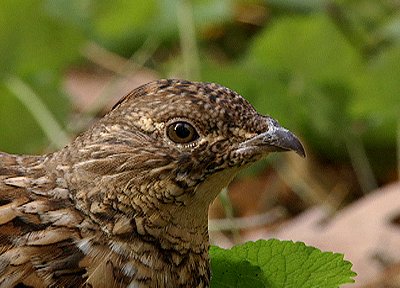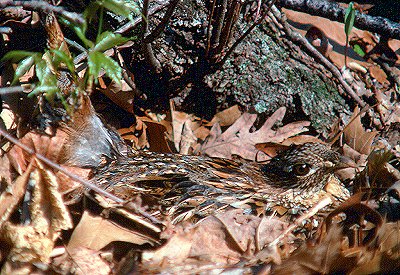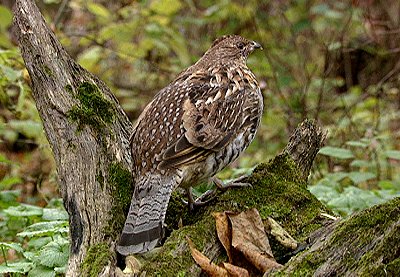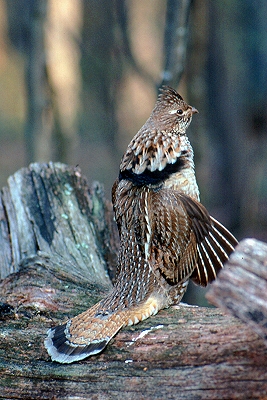Read about the Ruffed Grouse and how to photography the Ruffed Grouse.
 About twenty-five years ago, I was teaching outdoor education classes at Silver Lake, N. J. for the Fair Lawn school system. On my first nature walk class of the day, one of the teachers showed me a feather that he had picked up on a bird walk early that morning and he asked me if I could tell him from what bird the feather had come.
About twenty-five years ago, I was teaching outdoor education classes at Silver Lake, N. J. for the Fair Lawn school system. On my first nature walk class of the day, one of the teachers showed me a feather that he had picked up on a bird walk early that morning and he asked me if I could tell him from what bird the feather had come.
Before I could answer, the gym teacher, as sarcastic a person as I have ever met, spoke up, “Of course he can, and he can tell you whether it’s male or female and how many children it has.”
I looked carefully at the feather and said, “As a matter of a fact, I can. This feather came from a ruffed grouse’s tail and it came from the right side as you can see that the barbs are longer on the right side than they are on the left. The feather is from a female because it’s less than 5 ¼ inches in length. Because it is early May, and she is a female, she should be incubating ten to twelve eggs right now.”

The kids were delighted that I had silenced my skeptic and wanted to know how I could tell so much from just one feather. I then explained that, after years of study and observation, I had just written a book on the ruffed grouse the previous year. It’s to give you folks, my readers, the benefit of those years of research that I’m writing this column.
Of the ten basic grouse and ptarmigan families found in North America, the ruffed grouse has the largest range. It is found in the boreal forests from the Atlantic to the Pacific, up to Alaska and down the Rocky Mountains to Colorado and in the Appalachians to Georgia. Unfortunately, the ruffed grouse population is steadily shrinking over most of its range, mainly because of the destruction of its habitat by the tremendous population surge of the white-tailed deer. The grouse needs brushy cover in which to survive, and brush is the whitetail’s favorite food. As the hungry deer devastate the forest understory, and in many places completely prevent forest regeneration, the ruffed grouse population is decimated.
In my home area of northwestern New Jersey, the ban on traps and the low price of fur has allowed for eruptions of both raccoon and opossum populations. Both of these predators literally vacuum the forest floors and brush rows for the eggs of any and all ground-nesting birds and this takes a tremendous toll on the ruffed grouse.
Even under the best of conditions, the ruffed grouse population is cyclic, having a “boom and bust” swing once every ten years. The latest evidence seems to indicate that these cyclic swings are caused by parasites. Be that as it may, in even the best of ruffed grouse habitat, there will be years when the ruffed grouse will be plentiful and years when they will not.

These swings are going to occur whether the ruffed grouse are hunted or not. This was proven in the New York State study done in 1947 by Bump, Darrow, Edminster and Crissey. As part of that monumental study, hunters were paid to try to shoot out areas of grouse and it could not be done. The greater the hunting pressure, the more wary the grouse became. The greatest threat to the ruffed grouse is the destruction of their habitat by man and the deer.
If you live in the areas that I have mentioned and want to photograph grouse, there are a number of things that you can do to get help in locating them. First, and foremost, is to contact your state game commission. Every game department has excellent biologists who know just what kind of critters live in just what particular areas in their state. In many cases, they can actually pinpoint the precise location for you to start your search for individual birds.
Of all the grouse, the blue, spruce and ruffed grouse are the most individualistic. They do not gather in leks, or booming grounds, as do the sharptails, prairie chickens or the sage grouse. They are not found in open areas as the three ptarmigan are so that their activities can be seen for long distances. Of the blue, spruce and ruffed grouse, I have found the ruffed grouse to be the hardest to work with because it is hunted more frequently, has been subjected to more pressure by man because it lives in closer proximity to man and thus has become far more wary and secretive.
In true wilderness areas, the ruffed grouse are as tame as the blue and spruce grouse, both of which are nicknamed “fool hens” because of their lack of fear of man. One time, many years ago, when I was guiding canoe trips in the virgin wilderness areas of Quebec, Canada, I was actually able to stalk close enough to a covey of ruffed grouse that I was able to trap some under an overhanging bank and catch one of the birds with my bare hands. That doesn’t happen today.
As most of you know, I am extremely hard of hearing and am only able to hear regular conversation using two of Bob Walker’s Game Ears. Even with these superb hearing aids, I simply cannot hear many, perhaps I should say most, of the subtle wildlife noises that others hear in the out-of-doors. The best way to locate ruffed grouse is to go to good grouse habitat in early spring and listen for the male “drumming”. Ruffed grouse may drum in any month of the year and at any time of the day or night, but the drumming usually starts in early March, peaks in April and tapers off at the end of May.

The drumming serves the dual purpose of proclaiming the male’s territory and his determination to defend it, and as an attractant to the female to come in to be bred. Under the best of conditions, there are seldom more than four adult males to the square mile so it is imperative that you find the drumming log; it’s a lot like looking for the proverbial needle in a haystack.
The drumming is usually done from a log in 95% of the cases, but I have seen ruffed grouse drum while sitting on top of a large stone, a stump, a mound of dirt and even while sitting on a large grapevine that was on top of an old stone row.
The preferred log is huge, old and moss-covered, with the root structure still attached, usually the trunk of a tree that has fallen naturally, although as long as it is almost horizontal it can be the trunk of a tree that has been cut down. The log may be solid, rotten or even hollow. It is usually more than twelve inches in diameter.
The male ruffed grouse prefers a large diameter log because it provides greater elevation, allowing him to see farther. He prefers open hardwood forests because they are leafless in early spring and he can more clearly see anything that moves nearby. He prefers some brush or saplings at one end of the log into which he can escape if predators come in. Such cover also masks his arrival to and from the log. He favors a log on the southern side of a hill because that area will warm up first in the spring and provide him with the nutritious shoots and sprouts upon which he feeds. You can tell if a log is being used because there will usually be a pile of droppings at one end of the log and the log will show signs of wear in the precise spot the male uses for his drumming. And he uses the same precise spot and faces the same direction every time.
Even folks with good hearing will be able to locate drumming grouse farther if you do as I do. I use a bionic ear, a battery-powered sound magnifying device that comes with headphones and a parabolic booster. As I walk along, I just sweep the parabolic back and forth and every sound is magnified back to me. You cannot walk fast and do this because most grouse only drum on the average of once every five minutes. You can get your own Bionic Ear by calling Silver Creek Industries at 920-684-1225. As you can use it to help you locate all kinds of wildlife, you will wonder how you ever did without it.
 After you have located your grouse, you will need to put up a Rue Blind, as all of your work will have to be done from a blind. I have found that the closeness of the blind does not seem to affect the grouse, but I do recommend that you keep the blind as far from the grouse as is possible according to the lens you plan to use. Always try to minimize pressure on your subject. You can place the blind head on to the drumming spot or off to one side. Or you can work one direction for a couple of days and then change the blind to give you another angle. I prefer to use two flashheads, a main one close to my lens port and a fill light higher and to the side. I cover these flashheads with waterproof jackets and leave them in place at all times, just running their connecting cords into the blind. I take my battery pack with me to be recharged each night.
After you have located your grouse, you will need to put up a Rue Blind, as all of your work will have to be done from a blind. I have found that the closeness of the blind does not seem to affect the grouse, but I do recommend that you keep the blind as far from the grouse as is possible according to the lens you plan to use. Always try to minimize pressure on your subject. You can place the blind head on to the drumming spot or off to one side. Or you can work one direction for a couple of days and then change the blind to give you another angle. I prefer to use two flashheads, a main one close to my lens port and a fill light higher and to the side. I cover these flashheads with waterproof jackets and leave them in place at all times, just running their connecting cords into the blind. I take my battery pack with me to be recharged each night.
Grouse are very early risers and I strongly suspect that some males even sleep on their drumming logs. You have to be in your blind at least by 3:30 a. m. Most grouse that I have worked with usually come in between 4:00 and 4:30 a. m. at the latest. Flush a grouse off his drumming log by coming in late and you might as well go back home.
I get in the blind set up my cameras on my tripod, connect the strobe cords to the battery pack and focus the camera by shining a bright flashlight on the bird’s precise drumming spot, compose the frame, then just wait. DO NOT make any noise just sit silently. The grouse is always exceptionally wary when he first comes in; let him drum a number of times to build up confidence. Then I turn on my strobe power pack. As you have already pre-focused your camera, you don’t have to do anything but push your shutter release. Take your first photos in the middle of a drum roll. Being preoccupied with drumming, the grouse will pay very little attention to the flash of your strobe light and the rewinding of your camera. After that, shoot when you want to.
Most grouse leave the drumming log by 7:30 a. m. if nothing scares them from the log sooner. Occasionally some males will stay until 10:00 or 11:00 a.m. This is a real bonus because at such times you can also get photos of the male when he is off the log feeding on the nearby vegetation and this also allows you to get photos of the bird on the log without using flash.
DO NOT get out of the blind until after the bird has left the area, as you don’t want him to associate the blind with people. I do not recommend trying for photos in the late afternoon because you might scare the bird from the immediate area when you get out of the blind after dark. You should get all the photos you need by just working mornings. You will put in long hours, but the results will be worth every minute of it.
by Dr. Leonard Lee Rue III

Leave a Reply